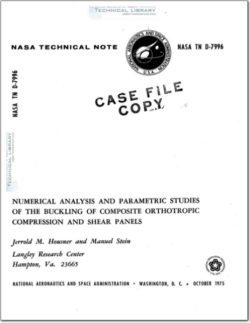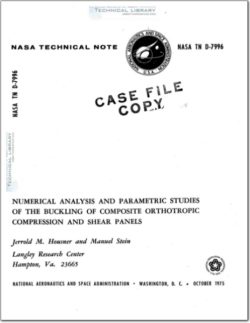NASA-TN-D-7996

- Version
- 672 Downloads
- 4.99 MB File Size
- 1 File Count
- November 27, 2015 Create Date
- November 27, 2015 Last Updated
Buckling Of Composite Orthotropic Panels

A computer program has been developed for the combined compression and shear
of stiffened variable thickness orthotropic composite panels on discrete springs; boundary
conditions are general and include elastic boundary restraints. Buckling solutions are
obtained by using a newly developed trigonometric finite —difference procedure which
improves the solution convergence rate over conventional finite-difference methods. The
trigonometric finite—difference procedure introduces two new parameters into the solution.
‘hese parameters can be computed by the program or selected by the user. The validity
f the program has been substantiated by comparisons with existing solutions, and a pro—
ram listing, input description, and sample problem are provided.
The classical general shear-buckling results (in terms of universal orthotropic
arameters), which exist only for simply supported panels over a limited range of ortho—
ropic properties, have been extended to the complete range of these properties for sim-
ly supported panels and, in addition, to the complete range of orthotropic properties for
lamped panels. The program has also been applied to parametric studies which exam—
me the effect of filament orientation upon the buckling of graphite —epoxy panels. These
studies included an examination of the filament orientations which yield maximum shear
or compressive buckling strength for panels having all four edges simply supported or
clamped over a wide range of aspect ratios. Panels with such orientations had higher
buckling loads than comparable, equal ~weight, thin-skinned aluminum panels. Also
included among the parameter studies were examinations of combined axial compression
and shear buckling and examinations of panels With rotational elastic—edge restraints.
The use of filamentary composite materials in aircraft and space structures offers
a potential for weight savings over conventional (all metal) construction. Also, compos-
ites introduce added versatility into the design process by allowing the structure to be
better tailored to meet the design criteria. One such design criterion is the prevention
of compressive and shear buckling in panels of laminated construction. In laminated
panels the stiffness properties can be tailored by controlling the filament orientation in
each lamina.
| File | Action |
|---|---|
| NASA-TN-D-7996-Buckling-of-Composite-Orthotropic-Panels.pdf | Download |
Comment On This Post